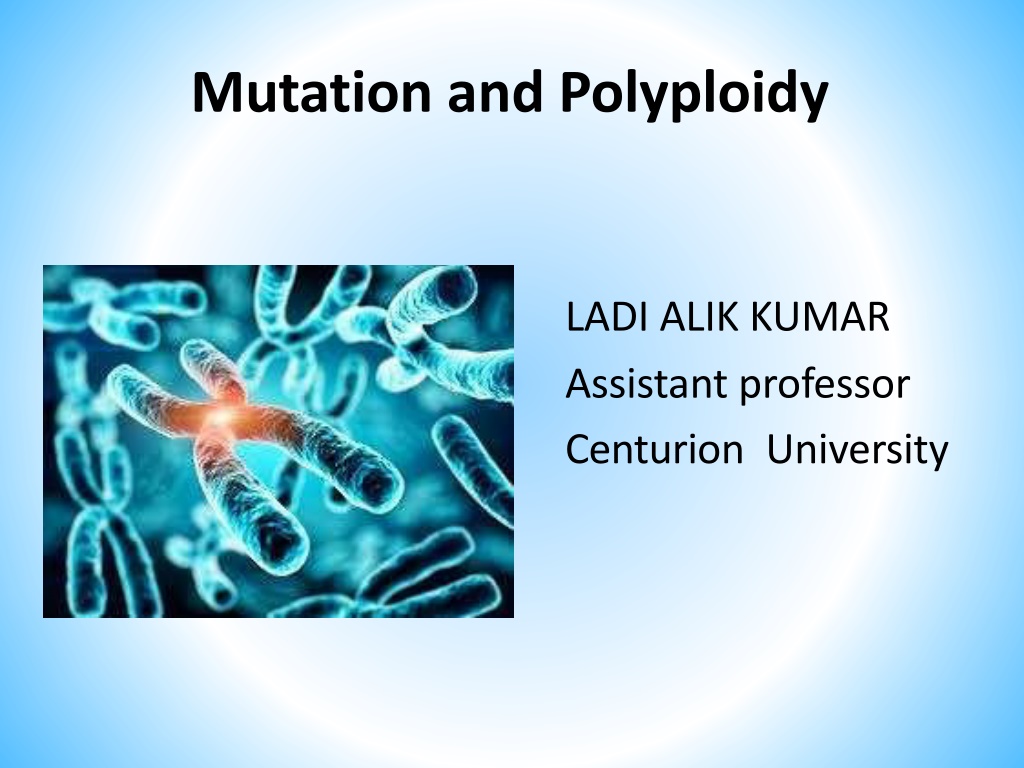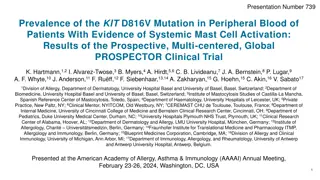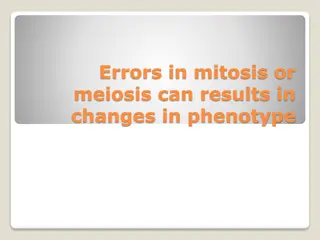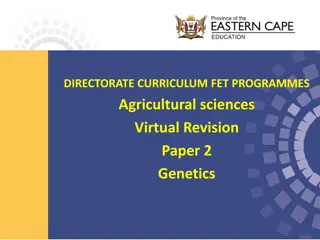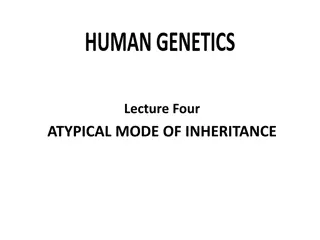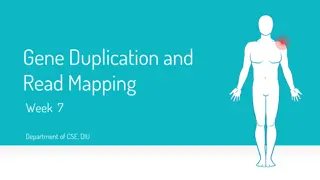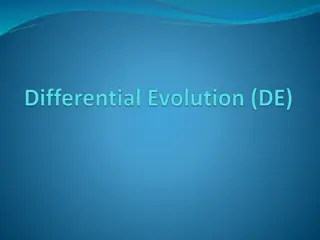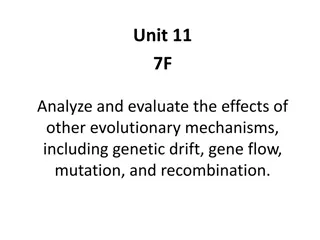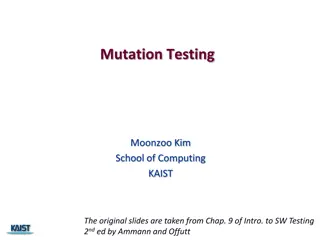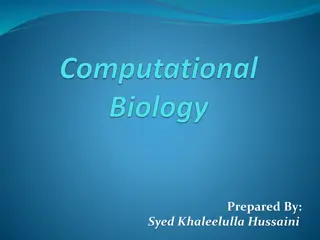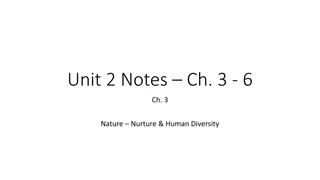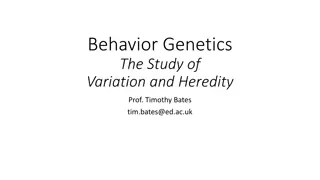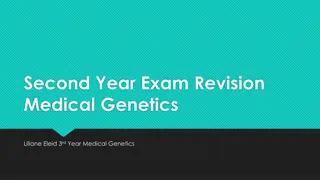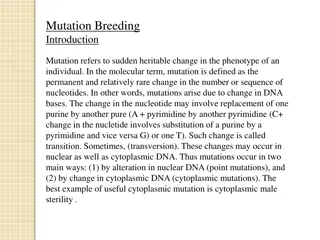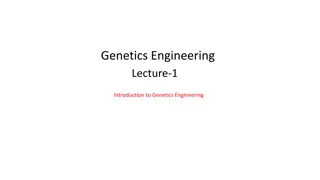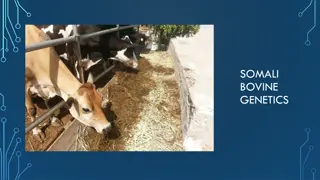Understanding Mutation and Polyploidy in Genetics
Mutation is a sudden hereditary change in an organism's genetic makeup, leading to variations in offspring. This article delves into the history, types, and causes of mutations, featuring significant discoveries by scientists like De Vries and Morgan. It also explores the concept of spontaneous mutations and their impact on DNA replication. Additionally, the mention of polyploidy highlights how variations in chromosome number contribute to genetic diversity.
Download Presentation

Please find below an Image/Link to download the presentation.
The content on the website is provided AS IS for your information and personal use only. It may not be sold, licensed, or shared on other websites without obtaining consent from the author. Download presentation by click this link. If you encounter any issues during the download, it is possible that the publisher has removed the file from their server.
E N D
Presentation Transcript
Mutation and Polyploidy LADI ALIK KUMAR Assistant professor Centurion University
*Mutation- Introduction Mutation is a sudden, hereditary change in the genetic make up of an organism. The offspring resemble their parents in one or several aspects, yet there are differences between the two. These differences whether large or small are called variations. Mutation is discontinuous variation. In molecular term, mutation is defined as the permanent and relatively rare change in the number and sequence of nucleotides.
*History of mutation Little was known about mutation before 19th century. Darwin first noticed sudden changes in the organisms in nature and referred those changes as sport or mutation . In 1901 Hugo De Vries observed sudden changes in Oenothera lamarkiana such as Gigas(Large sized), nanella(dwarf) and other unusual changes.. De Vries called those sudden changes as mutation and were published in a book entitled The Mutation Theory.
The case of mutation was first noticed in England by Wright in 1791 in male lamb which had short legs, The ancon sheep had a short leg that appeared suddenly in flock of sheep and disappeared later. Again after 80 years they reappeared in Norway. Morgan in 1904 reported white eyed Drosophila melanogaster in the population of red eyed flies.The term mutation was coined by De Vries.He derrived the term Mutation from the latin word mutare meaning to change. Mutation described by De Vries in Oenothera Lamarkiana are now known to be due to variation in chromosome number or ploidy and structural changes in the chromosomes.
After discovery of white eyed mutant, Morgan and his co-workers and other scientists have reported 500 mutants of Drosophila. Several cases of mutation have been observed in Neurospora, bacteria(E. coli) and bacteriophages, plants(pea, snapdragon, maize )etc and animal (rodents, fowl, men etc)
*Types of mutation On the basis of origin( causing factors) Spontaneous and induced mutation
*Spontaneous mutation Spontaneous mutations are those that arise occasionally in the absence of a known cause, i.e., without exposure to external agents. These mutations may result from errors in DNA replication, or from the action of transposons, or even from the effect of some mutagenic agents present in the environment.
*Spontaneous mutations Caused mainly by: Spntaneous replication errors.. 1.Tautomeric shifts 2. Wobble base pairing 3. Strand slippage 4. unequal crossingover 5. Spontaneous Chemical Changes : Depurination, Deamination
*Induced Mutations Caused by exposure to a mutagen Causes Exposure to base analogs Chemical mutagens Intercalatingagents Uv- radiation Transposable elements Mutator genes
*Induced mutations The mutation which are caused artificially in the living organisms are called induced mutations. Under experimental or artificial conditions induced mutations are caused. Any physical or chemical agent which introduces mutation in an organism is a mutagen or mutagenic agent. .-
Types of mutation (on the basis of origin) Mutation is of two types i)gene mutations or point mutations and ii)chromosomal mutations. Gene mutations -include changes in the structure or composition of genes whereas chromosomal mutations or chromosomal aberrations involve changes in the structure or number of chromosomes
*i) Gene mutation or Micromutation * It is caused due to change in the structure of the individual gene of DNA molecule. It results due to change in nucleotide sequence of DNA molecule at particular region of chromosome.It involves just one or two bases in DNA molecule. Hence it is also called point mutation.
Gene mutation or Point Mutation Sickle Cell disease is the result of one nucleotide substitution Occurs in the hemoglobin gene
*Types of gene mutation Gene mutation may be caused due to following changes in DNA and RNA. Substitutions Insertions Deletions Frameshift
*Substitution mutation One base pair is replaced by a different one is called substitution mutation. It occurs by two types (i) Transitions- In transition, a purine is replaced by another purine and a pyrimidine is replaced by another pyrimidine i.e., A = T is replaced by G = Cor vice-versa. (ii) Transversions- In trans version, a purine is replaced by a pyrimidine or a pyrimidine by a purine, i.e., C = G is replaced by G = C or A = T is replaced by T = A.
A frameshift mutation is a genetic mutation caused by a deletion or insertion in a DNA sequence. There is shift in reading frame forward or backwarsd by one or two nucleotides. Frameshift mutations arise when the normal sequence of codons is disrupted by the insertion or deletion of one or more nucleotides It results in abnormal protein products with an incorrect amino acid sequence that can be either longer or shorter than the normal protein.
*Types of Frameshift mutatiom Addition or insertion mutation- It is caused by addition of one base pair to a gene. All the triplets after insertion are affected Deletion It is the point mutation caused by loss ofone base pair in a triplet code
* Amino Acid Sequence Changed
*Chromosomal Aberrations It is cause either by change in structure of chromosomes called A) chromosomal aberrations(change in chromosome number) or -B) Genomatic mutation of ploidy (Change in chromosomal number)
B. Changes Involving Change in the Structure of Chromosomes: Some accidents sometimes occur which end in the breaking-down of chromosomes. The broken bits may get healed up or get re- attached in a wrong way or may even get lost. structural modifications of chromosome occur in nature or by harsh treatment, chiefly by X- rays and other ionising radiations.
Deficiency: A deficiency has a bit of a chromosome lost altogether. Some genes are, therefore lost. A deficiency may be terminal when it involves the end of a chromosome, or intercalary when it is an intermediate part that is deficient. Intercalary deficiency is also called deletion. Both terminal and intercalary deficiencies are known in maize
Duplication: A broken bit of a chromosome may remain free in the nucleus as a fragment in addition to two complete homologues. However, no such fragment can survive if it does not contain a centromere. Thus, some alleles will be represented thrice. The broken bit, instead of remaining free may also remain attached to some other broken chromosome (which may or may not be its homologue) at an intercalary position. It should be remembered that there can be no attachment to the unbroken telomere end.
Translocation: A broken bit of a chromosome may get attached to some other chromosome. Translocations are usually reciprocal somewhat resembling crossing-over but very different from the latter as whole chromosomes are involved here. Such reciprocal translocation may involve homologous or non-homologous chromosomes. Simple translocation of only one bit of a chromosome to another is extremely rare. If that rare event happens, the broken bit may even get re-attached in a different position on the motherchromosome.
Inversion: A segment of a chromosome gets inverted during reattachment. Thus, a chromosome having the genes abcdef in linear order may get the segment cd inverted. Then the new arrangement will be abdcef.
*Gene Mutation Animation
* Chromosomal mutation or macromutation Chromosomal mutation is caused by- change in structure of chromosome (chromosoma l aberration) and Due to change in chromosomal number(ploidy)
* Chromosomal in the wrong Large pieces of chromosome may break off and be lost or reattach themselves Mutations(chromosomal aberration) place. Five types exist: Deficiency Deletion Duplication Inversion Translocation
*Deficien cy Loss of terminalsegment ABCDEF- ABCD(EF is missing) Deletion Loss ofinteracalary segment ABCDEF- ABCD
*Duplicati on Segment or partof chromosome gets repeated ABCDEFGH- ABCDEFEFGH
*Inversi on Chromosome segment breaks off Segment flips around backwards Segment reattaches
*Translocatio n Involves two chromosomesthat aren t homologous Part of one chromosome is transferred to another chromosomes ABCDEF/IJKLMN- ABCDMN/IJKLEF
*Genomatic mutation or ploidy Mutations caused by the change in number of chromosomes is called ploidy or genomatic mutation. It occurs mainly of two types- Aneuploidy and Euploidy
*Aneuplo idy In aneuploidy the chromosome number is either one or more less or mor than the original number of chromosomes. Thus the total number of chromosomes is not exactly the multiple of haploid number. It is of following types- Monosomics- due to loss of one chromosome from a complet set of chromosomes( 2n-1) Nullisomics- Loss of single pair of chromosome(2n-2) Polisomics- addition of one or more chromosomes Trisomics(2n+1) Tetrasomics(2n+2)
When the chromosome complement is increased by one chromosome, it is called trisomic (2n + 1). These are found in Drosophila and more common in plants. Organisms containing 2n 1 chromosomes are called monosomic but they are neither fertile and nor vigorous. When both the chromosome of a given pair are missing, the individual is called a nullisomic (2n 2). These are inviable in some species but viable in others.
If there are two homologues added to a chromosome pair, then it is called tetrasomic (2n + 2)
*Euplo idy It includes the addition or loss of complete one set of chromosomes. An organism with the basic chromosome number 7, may have euploids with chromosome number 7, 14, 21, 28, 35, 42. Euploids are further of different types monoploids, diploids and polyploids.
In monoploidy or haploidy, it involves loss of complete one set of chromosomes. From the diploid set.Monoploids are usually smaller and less vigour. Eg. Male wasps, bees
*Polyplo idy It involves the addition of one or more sets of chromosomes An organism having more than two sets of homologous chromosomes is known as polyploid and the phenomenon polyploidy. It was discovered by Lutz. It is rarely found in animals but is of general occurrence in plants. eg in a diploid organism.
Depending on whether polyploids are produced from chromosome sets of single species or from two different species, polyploidy is classified into two types- i) Auto-Polyploidy, ii) Allopolyploidy, *Types of polyploidy
(i) Auto-Polyploidy: Auto-Polyploids are derrived from the multiplication of chromosomes of same species. Same basic set of chromosomes is multiplied. For instance, if a diploid species has two similar sets of chromosome or genomes (AA), an auto-triploid will have three similar genomes (AAA) and an auto- tetraploid will have four such genomes (AAAA), pentaploid(5n) andhexaploid(6n) The chromosomes replicate during anaphase but the cytoplasm fails cleavage duringcytokinesis. Autoploids have vigour and are largesized.
One of the very common example of natural auto-ploidy is found in doob grass (Cynodon dactylon). Auto-triploids (3n) are usually sterile and cannot produce seeds. Hence they are used in producing seedless varieties such as water lemons, tomato, banana, grapes etc. Likewise, auto-tetraploids are known in marigolds (Tagetes), maize (Zea mays), apples, and Oenothera, etc.
Autotetraploids: These usually show greater vigour, increased cell size, mainly in stomata and guard cells. The auto-tetraploidy leads the plant to perenniality and may show reduced fertility. Autotetraploids are slower in growth, have greater adaptability, variability and some times show disease resistance. Because of their greater economic importance and breeding possibility, auto- tetraploids are now induced artificially. Auto-tetraploids have been reported in Sorghum, wheat, rice, maize, chilli, red gram, black gram, green gram, bengal gram, cotton, guava, coffee etc. It may arise by somatic doubling and somatic doubling generally happens by the failure of first meiotic division in the zygote.
(ii) Allopolyploids: Polyploidy may also result from doubling of chromosome number in hybrid which is derived from two or more distinctly different species. This brings two (or more) different sets of chromosome in hybrid. The doubling of chromosomes in the hybrid, which gives rise to a Polyploidy, is called an allopolyploid.
An allotetraploid has been produced by by crossing Raphanus sativus (2n = 18) and Brassica oleracea (2n = 18). The hybrid formed by crossing these two species is itself a diploid (2n = 18). It contains only one set of radish chromosome (n = 9) and one set of cabbage (n = 9) chromosomes. The hybrid differs from both the parents and showed many characters of both. It is almost sterile, because radish and cabbage chromosome are so different that they do not pair or fail to pair at meiosis I. But the hybrid forms an occasional gamete which contains one complete set of radish chromosomes and one complete set of cabbage chromosomes.
When such two gametes combine they produce a plant which contains two sets of radish chromosome and two sets of cabbage chromosomes (18+18 = 36). These F2 progenies were fertile and tetraploids. This plant showed foliage like radish and root like cabbage. The fruit was peculier. It resembled the cabbage in its lower portion and the radish in its apical portion. The allotetraploid bred true, hence of no practical value. As it combines characters of both radish and cabbage, therefore, has been namedRaphanobrassica.
Some of the synthetic allotetraploids resemble closely with the existing species. Various species like wheat, cotton, tobacco etc. might have developed by this method. During the recent years a new genus Triticale has been synthesised by combining the chromosome of Triticum duram and Secale cereale (rye). This new genus Triticale is a very useful allopolyploid (2n = 56).
*Techniques of Inducing Polyploidy: 1. Decapitation: It has been found in various seedlings that if their tip is removed or cut off by a sharp knife the callus is produced which give rise to some polyploids. 2. Graft combinations: It has been observed that callus formation occurs during the graft combinations i.e., 7% (fusion of stock and scion) which may lead to some extent polyploidy Winkler, 1916. 3. Radiations: Irradiation of vegetative and floral buds with X-rays, gamma rays or ultra-violet rays, polyploidy may be brought in some frequencies.
4. Temperature: Application of heat and cold shocks to flowers at or near the time of first division of zygote brings about polyploidy. 5. Hybridization: It also to some extent brings about polyploidy. 6. Chemicals: the most effective results have been obtained by colchicine and this is now being widely used on all plant species. There are various chemicals like chloral hydrate, acenaphthelene, coumarine, vertanine sulphate cavadin, vernatrine, ethyl mercury chloride, vitamin sulphate, granosan, hydroxyquinoline and nitrous oxideetc.
